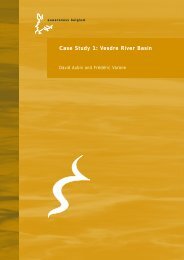Case Study 1: Matarraña River Basin - Euwareness
Case Study 1: Matarraña River Basin - Euwareness
Case Study 1: Matarraña River Basin - Euwareness
You also want an ePaper? Increase the reach of your titles
YUMPU automatically turns print PDFs into web optimized ePapers that Google loves.
epresents the emergence of a social movement claiming for a new water policy<br />
paradigm based on water demand strategies that promote resource savings and<br />
efficiency in their use and on the conservation of the resource, both in its quality and<br />
quantity. At the basin level, the second half of the nineties represents the first breaking<br />
with the traditional perspective. A social opposition movement supported by<br />
environmental groups and experts criticises the unsustainable economic and technical<br />
rationality; denounce the environmental negative effects of the regulation projects<br />
constructed within the basin; and claim for the valuation and conservation of the fluvial<br />
ecosystem of the <strong>Matarraña</strong> river in response to the hydraulic policy promoted by the<br />
State administration. The construction of the pumping project will mark the breaking<br />
point for this rupture. It will constitute the main argument of the social claims and will<br />
result in a territorial conflict among the water uses within the basin.<br />
The pumping project<br />
After the construction of the tunnel in 1978 there was a large drought period which<br />
lasted to 1987 and led to a new wave of social demands for regulation projects in order<br />
to guarantee farm production. Several dam projects were proposed during the<br />
seventies and eighties: El Pontet, Torre del Compte and Molí de les Roques, among<br />
others. The wet period that followed, which started with the 1988 floods, relaxed the<br />
irrigation farmers and administration claims for regulation until the beginning of the<br />
nineties. In 1993 a new drought period started and the controversy reappeared. In this<br />
context, in I994 the Central Union studied the possibility of pumping water up from a<br />
lower point in the <strong>Matarraña</strong> river to the Pena dam. Finally, the Central Union rejected<br />
the project for considering it as having a too high economic cost. It was the national<br />
government the one approving new regulation in response to the drought period from<br />
1992 to 1995: it provided the legal framework and financial resources to carry out the<br />
pumping project 3 . The mentioned regulation declared several projects, included the<br />
pumping one in the <strong>Matarraña</strong> river, of general interest of the State and were<br />
considered as urgent measures in order to palliate the drought effects. By this, these<br />
projects were approved avoiding the parliamentary debate which had to carry out a<br />
deep reflection on the future water policy and planning criteria (the National<br />
3 Real Decreto-Ley 4/1995 por el que se adoptan medidas urgentes para reparar los efectos<br />
producidos por la sequía, y Real Decreto-Ley 6/1995 por el que se adoptan medidas<br />
48



